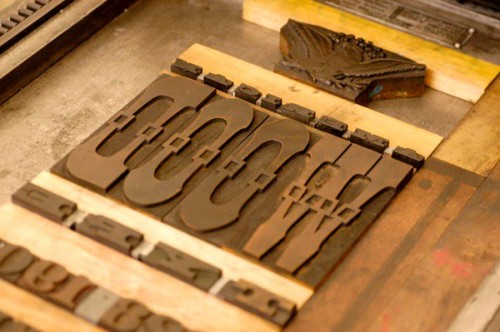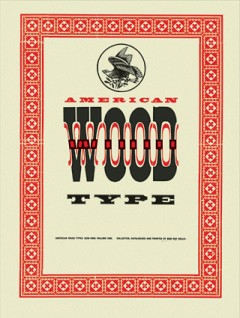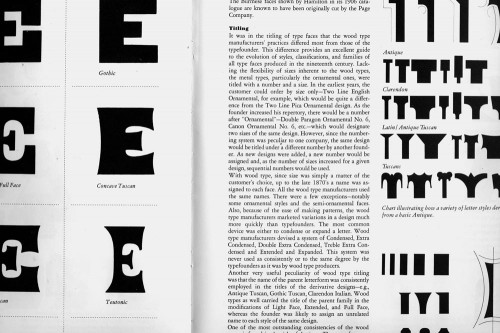“American Wood Type” reissued
Thirty-three years after its most recent printing, Rob Roy Kelly‘s seminal book on wood type, American Wood Type: 1828–1900, will finally be offered in newly printed form. The 350-page tome is being republished in paperback form by Matt Kelsey at the Liber Apertus Press in Saratoga, California. Kelsey informs me that the book is being printed digitally, on-demand, from high-resolution scans of the original 1969 hardcover edition. It will be made available starting March 31 for a retail price of $29.95.
The news will come as a relief to many students and others who have not been able to afford the prices which are usually asked for second-hand copies of the book. Both previously available editions — a 1969 hardcover by Van Nostrand Reinhold and a 1977 paperback by Da Capo Press — have been increasingly difficult to find at affordable prices. For example, at the time of writing this, only two copies are currently available on Amazon.com, both with price tags of at least $750. Thrifty buyers have been able to get the book for much cheaper (I lucked out on a first-edition hardcover on eBay for $95 last October), but such deals have become few and far between.
This newest reissue features a short foreword by David Shields, caretaker of the Rob Roy Kelly American Wood Type Collection, in which he gives a brief history of the book and explains the impact it continues to have on designers and printers (myself included). Shields has also designed a new cover with types from the collection, inspired by the cover of Kelly’s 1964 folio precursor to the book.
In all other regards the book will be printed as a facsimile and, as such, will retain various typos and historical inaccuracies which David Shields and others have uncovered since the book’s first publication more than 40 years ago. While this is less than ideal, a proper follow-up would undoubtedly require much more work, time, and money; essentially it would be a different project. Shields’ foreword addresses these issues, referring readers to the Kelly Collection website for more current information (at least for the types in the collection).
One of the many reasons a reissue of the book has taken so long is related to the complexities and uncertainties surrounding its copyright information. The original 1969 publisher (Van Nostrand Reinhold) and copyright holder (Reinhold Book Corporation) were split and merged with other corporations several times over the years, with the rights to the book being moved around, licensed on a temporary basis (for the 1977 Da Capo Press reissue), and generally changing hands on numerous occasions. Despite, and perhaps because of this, the original publishing agreements cannot be found.
With the help of Rob Roy Kelly’s widow, Mary Helen, Kelsey researched and contacted all of the known corporate successors who acquired all or portions of the Van Nostrand Reinhold assets, and all have stated that they do not control the rights to the book. Kelsey’s conclusion — based on provisions that were common in agreements for scholarly works at that time — is that the rights have reverted to the author’s estate after the book went out of print. Under this belief, Mary Helen Kelly has granted a license to Liber Apertus Press for a reissue. For the first time the author’s family will receive royalties from sales of the book.
For those who are curious as to why a reissue of American Wood Type isn’t being carried out by a more notable or relevant organization — like Oak Knoll Press, RIT Cary Graphic Arts Press, Harry Ransom Center, or the Hamilton Wood Type & Printing Museum — the main reason that I can see is that Kelsey is the first to go to the trouble of researching and contacting all the possible copyright owners. Also, as a smaller on-demand publisher, Kelsey avoids higher investment costs that other publishers might have to put up for traditional printing and binding processes.
Adding another generation to the production process by scanning from a print will likely have some affect on the fidelity of the book’s reproduction, but I doubt it will be anything that would make the book worth anything less than $30. Indeed, the difference may be imperceptible. I’ve heard rumors that the original film negatives used to print the first edition still exist somewhere at Yale, which would be ideal for the purposes of reproduction (a proper digital scan of the negatives may even yield a better print than the 1969 edition), but I haven’t personally seen or heard anything concrete to that effect.
Liber Apertus previously took on a similar reprinting of the letterpress printing guide, General Printing, and plans to continue the series by reissuing other such books like American Wood Type that are in demand but out of print.
I must admit that my first gut reaction to the news that the book was being digitally reprinted, as a direct facsimile, using less-than-superior paper and binding, by a relatively tiny and unknown publisher, was something along the lines of skepticism. However, after remembering the shady lengths I went to in order to acquire my first copy of American Wood Type when I was a student (don’t ask), I ultimately think that having Kelly’s amazing book widely available again in any form is a good thing.




5 comments on “American Wood Type” reissued.
2010/03/18, 6:24am #
Shown (fully or partially) on page 86 above are: (1) Antique; (2) Gothic; (3) Clarendon Full Face; (4) Concave Tuscan; (5) Antique Tuscan; (6) Teutonic. The latter three examples are easy forms for a router bit to “cut in” because their outer corners are sharp and their inner corners are rounded. Working from the outside of the form toward the inside was the natural way to go for designers of wood type, as the pantograph became the tool of choice in manufacturing. Generally, a cut-in letter can be finished sooner if it needs no trimming.
2010/03/18, 7:30am #
This is interesting news despite having several of the out of print publication.
I wouldn’t be too concerned about the inaccuracies of the reprint. The beauty and wonder of the internet as a medium is that addenda such a book requires can be economically made available to anyone with a web connection.
It’s the direction many publishers are going in order to control costs in the effort to keep they publications up to date especially in the realm of academia.
UTA could/should allocate a URL now for those digital addenda which could be provided in the appendix, or some other reference point in the print edition to drive access to this ever-iterating information.
The best of both worlds.
mjb
2010/03/21, 10:24pm #
[…] Type, is being reissued. Read Nick Sherman’s thorough accounting of the project on his site, Woodtyper, then visit Liber Apertus Press to order your own […]
2010/03/26, 7:28am #
I couldn’t be happier!
2010/06/05, 2:27pm #
This is interesting news despite having several of the out of print publication.
I wouldn’t be too concerned about the inaccuracies of the reprint. The beauty and wonder of the internet as a medium is that addenda such a book requires can be economically made available to anyone with a web connection.
It’s the direction many publishers are going in order to control costs in the effort to keep they publications up to date especially in the realm of academia.
UTA could/should allocate a URL now for those digital addenda which could be provided in the appendix, or some other reference point in the print edition to drive access to this ever-iterating information.
The best of both worlds.
mjb